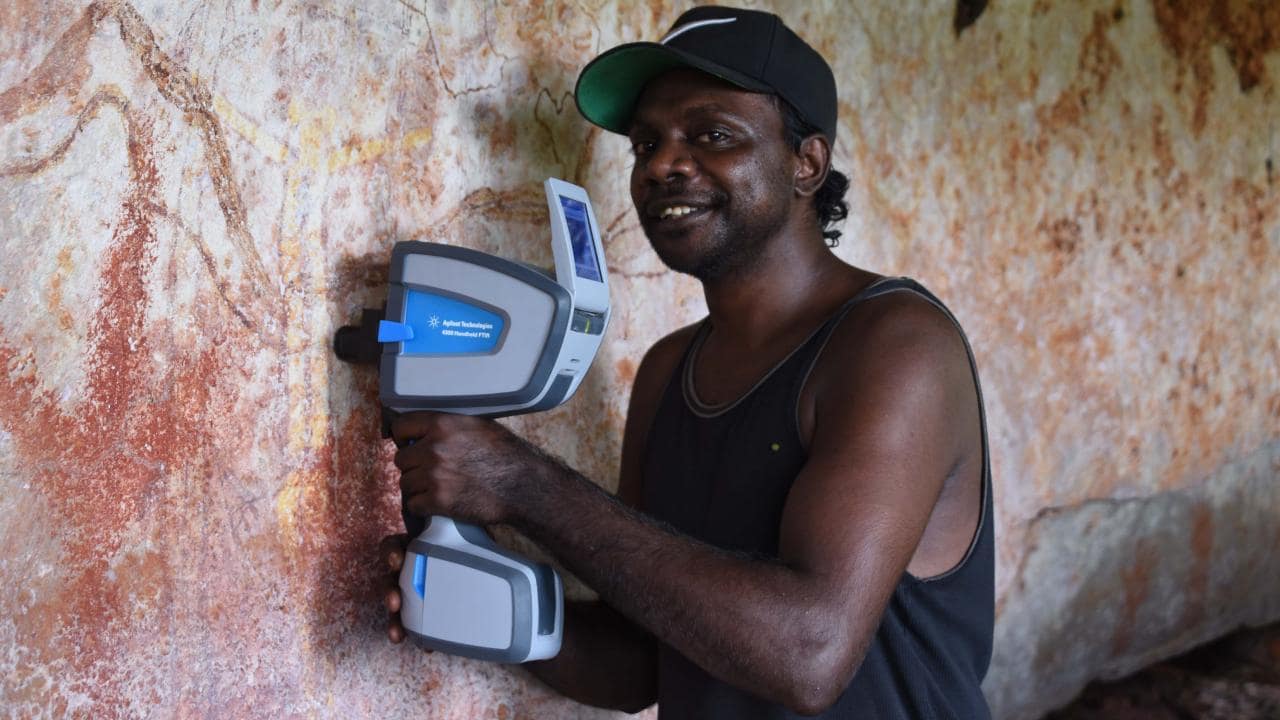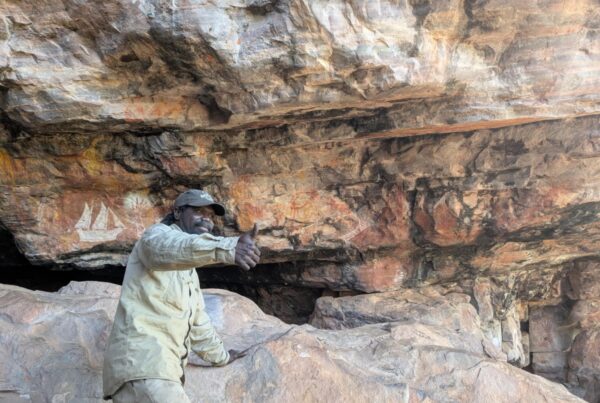Enigmatic human figures with elaborate headdresses, arm and waist decorations adorn rock shelters in the Kimberley region of Western Australia.
This style of art, known as Gwion, Kiro Kiro or Kujon, was painted by the ancestors of today’s traditional owners around 12,000 years ago, a new study suggests.

“It’s the first time ever that we’ve been able to say that these paintings are about a certain age,” said lead author Damien Finch.
The date of the art work, published today in the journal Science Advances, is based on radiocarbon dating of mud wasp nests. Download paper.
“When the mud wasp collects sand off the floor she’s also picking up tiny pieces of charcoal,” explained Mr Finch, a PhD student at the University of Melbourne.

As the traditional owners used fire to manage their country, the small black and yellow wasp built their time capsules above and below the artworks tucked away in the rock shelters.
While most Gwion paintings studied by the team had either had a nest under or over part of the artwork, one painting had two nests on top and one under.
“So that particular painting had to be between 11,000 and 13,000 years old,” Mr Finch said.
A rich record of stories
The Kimberley is renowned for its rich galleries of rock art.
The Gwion period, which used to be known as the Bradshaw paintings, is thought by archaeologists to be the second oldest of at least six distinct periods of creative styles depicting stories and songlines passed from generation to generation.
“The paintings are like a diary to me and my people,” said Kwini man Ian Waina.
But no-one is really sure how old they are.
“Tourists will ask ‘How old is that painting? I just say ‘I don’t know, it’s just older than me or you,” Mr Waina said.
But, he said, knowing the age was important for his people too.
“Everyone wants to find out how old the painting is,” he said.
“They just say this is from the ‘old people’.
“They know the stories, they are keeping those stories … but who is that story from? Is it from our older, older, older people?”
Working both ways
Over the past six years, archaeologists, scientists and pastoralists have been working with traditional owners such as Mr Waina to record rock art sites as part of the Kimberley Rock Art project.
“It’s an honour working both ways with the archaeologists and scientists,” Mr Waina said.

Each dry season, the researchers and traditional owners travel to sites by helicopter over the sandstone gorges and rivers that crisscross Balanggarra country, which stretches between Kalumburu and Wyndham.
Dating Australian rock art is extremely tricky, said Helen Green of the University of Melbourne.
“People have been trying to solve this problem for a long time so we’ve thrown every expertise and every expert at it,” said Dr Green, who is one of the study co-authors.
The art is too old to contain organic material in the pigment, so scientists date material that lies under or over an artwork to give an age range for when the painting was created.
Calcite deposits covering ancient artworks deep within limestone caves in other parts of the world such as Borneo have been reliably dated using a technique that measures how fast uranium decays into thorium.
But Australian rock art is painted on sandstone — which contains no calcite — and they are in overhangs exposed to the elements.

These overhangs are dusty, which also is a problem for uranium dating. That’s why researchers have turned to the industrious labour of mud wasps.
Their nests are a concoction of largely carbon from dry season burns mixed with sticks, pollen and insect shells.
Previous work, led by Mr Finch, showed the carbon was, on average, no older than 200 years in modern nests. Using this as a baseline, he could then date the ancient nests.
“The nests weather away as they get older,” Mr Finch said.
“My idea was that we could go for the smaller nests and we could date the carbon that’s in there.
Working with the traditional owners, the team recorded and collected samples from 24 nests lying over or under 21 Gwion paintings from across the Drysdale River National Park.
While the dating suggested most of the paintings were created in a short creative flourish around 12,000 years ago, one painting may have been as old as 16,000 years.

Comparing dating techniques
Bert Roberts, an archaeologist at the University of Wollongong said the work was the most systematic and comprehensive dating study of mud-wasp nests associated with Aboriginal rock art.
Professor Roberts, who is a member of the Kimberley Rock Art project but was not involved with this study, said the work established a reliable minimum age for the paintings.
“But he may not have captured the full time-depth of Gwion paintings,” he said.
In the late 1990s Professor Roberts estimated a single wasp nest over Gwion painting was 17,000 years old using a technique that estimates when grains of quartz last saw daylight.
“I suspect that fossilisation of nests over many millennia may limit how far back in time radiocarbon dating can reliably extend.”
But there may be limitations to the technique used by Professor Roberts too, said archaeologist Paul Taçon of Griffith University.
“The wasp nest [in the earlier study] was really big,” said Professor Taçon, who was not involved in the new study.
“Often mud wasps will go back and build new nests over top of old ones and the oldest part of the core of the nest was just off the art.
Professor Taçon said the new dates were similar to those he had proposed for artworks, known as dynamic figures, in Kakadu and Arnhem Land in the Northern Territory.
“Many people have shown the two are closely related styles made by related groups of people,” he said.
In the mid-90s Professor Taçon published a paper based on a range of archaeological evidence that suggested the dynamic figures in the Northern Territory were between 12,000 and 13,000 years old.
“This paper will encourage people to take the charcoal technique further and reliable dates can be obtained for really old art in northern Australia,” he said.

Past, present and future
Mr Finch said many more nests needed to be dated before scientists would “really have a handle” on the age of the paintings across the Kimberley.
“Was it really short and sharp period of painting around 12,000 years ago or did it build up over a period of time?” he said.
“Did it overlap with the earlier period and the subsequent art period? We don’t know that yet either.”
The scientists and archaeologists hope comparing the results from all the technologies will provide a more comprehensive picture.
But ultimately the focus should be on celebrating the oldest continuous culture on Earth, Dr Green said.
“The fact that this is the oldest ongoing culture is remarkable, the paintings are incredible,” she said.
“And the people who are related to the people who did these paintings are still there today.”
Mr Waina comes from a long line of painters. For him it’s about the past, present and future.









